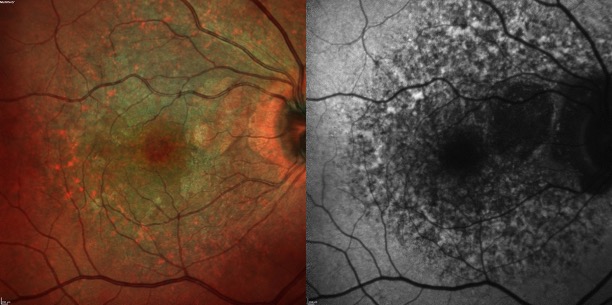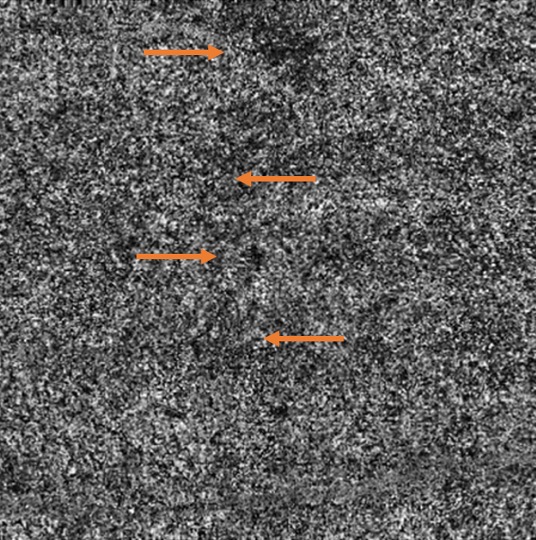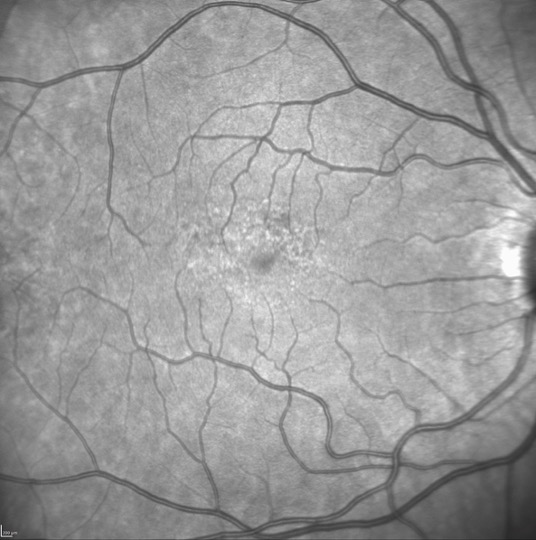[1]
Paredes Mogica JA, De EJB. Pentosan Polysulfate Maculopathy: What Urologists Should Know in 2020. Urology. 2021 Jan:147():109-118. doi: 10.1016/j.urology.2020.08.072. Epub 2020 Oct 10
[PubMed PMID: 33045286]
[2]
Herrero LJ, Foo SS, Sheng KC, Chen W, Forwood MR, Bucala R, Mahalingam S. Pentosan Polysulfate: a Novel Glycosaminoglycan-Like Molecule for Effective Treatment of Alphavirus-Induced Cartilage Destruction and Inflammatory Disease. Journal of virology. 2015 Aug:89(15):8063-76. doi: 10.1128/JVI.00224-15. Epub 2015 May 27
[PubMed PMID: 26018160]
[3]
Nickel JC, Moldwin R. FDA BRUDAC 2018 Criteria for Interstitial Cystitis/Bladder Pain Syndrome Clinical Trials: Future Direction for Research. The Journal of urology. 2018 Jul:200(1):39-42. doi: 10.1016/j.juro.2018.02.011. Epub 2018 Feb 13
[PubMed PMID: 29452126]
Level 3 (low-level) evidence
[4]
Lindeke-Myers A, Hanif AM, Jain N. Pentosan polysulfate maculopathy. Survey of ophthalmology. 2022 Jan-Feb:67(1):83-96. doi: 10.1016/j.survophthal.2021.05.005. Epub 2021 May 14
[PubMed PMID: 34000253]
Level 3 (low-level) evidence
[5]
Wang D, Velaga SB, Grondin C, Au A, Nittala M, Chhablani J, Vupparaboina KK, Gunnemann F, Jung J, Kim JH, Ip M, Sadda S, Sarraf D. Pentosan Polysulfate Maculopathy: Prevalence, Spectrum of Disease, and Choroidal Imaging Analysis Based on Prospective Screening. American journal of ophthalmology. 2021 Jul:227():125-138. doi: 10.1016/j.ajo.2021.02.025. Epub 2021 Feb 27
[PubMed PMID: 33651989]
[6]
Hanif AM, Armenti ST, Taylor SC, Shah RA, Igelman AD, Jayasundera KT, Pennesi ME, Khurana RN, Foote JE, O'Keefe GA, Yang P, Hubbard GB 3rd, Hwang TS, Flaxel CJ, Stein JD, Yan J, Jain N. Phenotypic Spectrum of Pentosan Polysulfate Sodium-Associated Maculopathy: A Multicenter Study. JAMA ophthalmology. 2019 Nov 1:137(11):1275-1282. doi: 10.1001/jamaophthalmol.2019.3392. Epub
[PubMed PMID: 31486843]
Level 2 (mid-level) evidence
[7]
Abou-Jaoude MM, Davis AM, Fraser CE, Leys M, Hinkle D, Odom JV, Maldonado RS. New Insights Into Pentosan Polysulfate Maculopathy. Ophthalmic surgery, lasers & imaging retina. 2021 Jan 1:52(1):13-22. doi: 10.3928/23258160-20201223-04. Epub
[PubMed PMID: 33471910]
[8]
Vora RA, Patel AP, Melles R. Prevalence of Maculopathy Associated with Long-Term Pentosan Polysulfate Therapy. Ophthalmology. 2020 Jun:127(6):835-836. doi: 10.1016/j.ophtha.2020.01.017. Epub 2020 Jan 17
[PubMed PMID: 32085877]
[9]
Wang D, Au A, Gunnemann F, Hilely A, Scharf J, Tran K, Sun M, Kim JH, Sarraf D. Pentosan-associated maculopathy: prevalence, screening guidelines, and spectrum of findings based on prospective multimodal analysis. Canadian journal of ophthalmology. Journal canadien d'ophtalmologie. 2020 Apr:55(2):116-125. doi: 10.1016/j.jcjo.2019.12.001. Epub 2020 Jan 20
[PubMed PMID: 31973791]
[10]
Bae SS, Sodhi M, Maberley D, Kezouh A, Etminan M. Risk of maculopathy with pentosan polysulfate sodium use. British journal of clinical pharmacology. 2022 Jul:88(7):3428-3433. doi: 10.1111/bcp.15303. Epub 2022 Mar 22
[PubMed PMID: 35277990]
[11]
Abou-Jaoude M, Fraser C, Maldonado RS. Update on maculopathy secondary to pentosan polysulfate toxicity. Current opinion in ophthalmology. 2021 May 1:32(3):233-239. doi: 10.1097/ICU.0000000000000754. Epub
[PubMed PMID: 33710012]
Level 3 (low-level) evidence
[12]
Jain N, Liao A, Garg SJ, Patel SN, Wykoff CC, Yu HJ, London NJS, Khurana RN, Zacks DN, Macula Society Pentosan Polysulfate Maculopathy Study Group. Expanded Clinical Spectrum of Pentosan Polysulfate Maculopathy: A Macula Society Collaborative Study. Ophthalmology. Retina. 2022 Mar:6(3):219-227. doi: 10.1016/j.oret.2021.07.004. Epub 2021 Jul 21
[PubMed PMID: 34298229]
[13]
Uner OE, Shah MK, Jain N. PENTOSAN POLYSULFATE AND VISION: Findings from an International Survey of Exposed Individuals. Retina (Philadelphia, Pa.). 2021 Jul 1:41(7):1562-1569. doi: 10.1097/IAE.0000000000003078. Epub
[PubMed PMID: 33332810]
Level 3 (low-level) evidence
[14]
Ludwig CA, Vail D, Callaway NF, Pasricha MV, Moshfeghi DM. Pentosan Polysulfate Sodium Exposure and Drug-Induced Maculopathy in Commercially Insured Patients in the United States. Ophthalmology. 2020 Apr:127(4):535-543. doi: 10.1016/j.ophtha.2019.10.036. Epub 2019 Nov 5
[PubMed PMID: 31899034]
[15]
Jain N, Li AL, Yu Y, VanderBeek BL. Association of macular disease with long-term use of pentosan polysulfate sodium: findings from a US cohort. The British journal of ophthalmology. 2020 Aug:104(8):1093-1097. doi: 10.1136/bjophthalmol-2019-314765. Epub 2019 Nov 6
[PubMed PMID: 31694837]
[16]
Shah R, Simonett JM, Lyons RJ, Rao RC, Pennesi ME, Jain N. Disease Course in Patients With Pentosan Polysulfate Sodium-Associated Maculopathy After Drug Cessation. JAMA ophthalmology. 2020 Aug 1:138(8):894-900. doi: 10.1001/jamaophthalmol.2020.2349. Epub
[PubMed PMID: 32644147]
[17]
Brandl C, Schulz HL, Charbel Issa P, Birtel J, Bergholz R, Lange C, Dahlke C, Zobor D, Weber BHF, Stöhr H. Mutations in the Genes for Interphotoreceptor Matrix Proteoglycans, IMPG1 and IMPG2, in Patients with Vitelliform Macular Lesions. Genes. 2017 Jun 23:8(7):. doi: 10.3390/genes8070170. Epub 2017 Jun 23
[PubMed PMID: 28644393]
[18]
Ishikawa M, Sawada Y, Yoshitomi T. Structure and function of the interphotoreceptor matrix surrounding retinal photoreceptor cells. Experimental eye research. 2015 Apr:133():3-18. doi: 10.1016/j.exer.2015.02.017. Epub
[PubMed PMID: 25819450]
[19]
Clark SJ, Keenan TD, Fielder HL, Collinson LJ, Holley RJ, Merry CL, van Kuppevelt TH, Day AJ, Bishop PN. Mapping the differential distribution of glycosaminoglycans in the adult human retina, choroid, and sclera. Investigative ophthalmology & visual science. 2011 Aug 17:52(9):6511-21. doi: 10.1167/iovs.11-7909. Epub 2011 Aug 17
[PubMed PMID: 21746802]
[20]
Burgess WH, Maciag T. The heparin-binding (fibroblast) growth factor family of proteins. Annual review of biochemistry. 1989:58():575-606
[PubMed PMID: 2549857]
[21]
Greenlee T, Hom G, Conti T, Babiuch AS, Singh R. Re: Pearce et al.: Pigmentary maculopathy associated with chronic exposure to pentosan polysulfate sodium (Ophthalmology. 2018;125:1793-1802). Ophthalmology. 2019 Jul:126(7):e51. doi: 10.1016/j.ophtha.2018.12.037. Epub
[PubMed PMID: 31229012]
[22]
Hochmann S, Kaslin J, Hans S, Weber A, Machate A, Geffarth M, Funk RH, Brand M. Fgf signaling is required for photoreceptor maintenance in the adult zebrafish retina. PloS one. 2012:7(1):e30365. doi: 10.1371/journal.pone.0030365. Epub 2012 Jan 26
[PubMed PMID: 22291943]
[23]
Bloom WR, Edakkunnathu A, Kondapalli SS, Bloom TD. Transient pemigatinib-induced subretinal fluid accumulation and serous retinal detachment. Clinical & experimental optometry. 2023 Jul:106(5):560-563. doi: 10.1080/08164622.2022.2086792. Epub 2022 Jul 6
[PubMed PMID: 35793865]
[24]
Fasolino G, Moschetta L, De Grève J, Nelis P, Lefesvre P, Ten Tusscher M. Choroidal and Choriocapillaris Morphology in Pan-FGFR Inhibitor-Associated Retinopathy: A Case Report. Diagnostics (Basel, Switzerland). 2022 Jan 20:12(2):. doi: 10.3390/diagnostics12020249. Epub 2022 Jan 20
[PubMed PMID: 35204340]
Level 3 (low-level) evidence
[25]
Parikh D, Eliott D, Kim LA. Fibroblast Growth Factor Receptor Inhibitor-Associated Retinopathy. JAMA ophthalmology. 2020 Oct 1:138(10):1101-1103. doi: 10.1001/jamaophthalmol.2020.2778. Epub
[PubMed PMID: 32789485]
[26]
Patel SN, Camacci ML, Bowie EM. Reversible Retinopathy Associated with Fibroblast Growth Factor Receptor Inhibitor. Case reports in ophthalmology. 2022 Jan-Apr:13(1):57-63. doi: 10.1159/000519275. Epub 2022 Feb 11
[PubMed PMID: 35350233]
Level 3 (low-level) evidence
[27]
Francis JH, Harding JJ, Schram AM, Canestraro J, Haggag-Lindgren D, Heinemann M, Kriplani A, Jhaveri K, Voss MH, Bajorin D, Abou-Alfa GK, Iyer G, Drilon A, Rosenberg J, Abramson DH. Clinical and Morphologic Characteristics of Fibroblast Growth Factor Receptor Inhibitor-Associated Retinopathy. JAMA ophthalmology. 2021 Oct 1:139(10):1126-1130. doi: 10.1001/jamaophthalmol.2021.3331. Epub
[PubMed PMID: 34473206]
[28]
Fogel Levin M, Santina A, Corradetti G, Au A, Lu A, Abraham N, Somisetty S, Romero Morales V, Wong A, Sadda S, Sarraf D. Pentosan Polysulfate Sodium-Associated Maculopathy: Early Detection Using OCT Angiography and Choriocapillaris Flow Deficit Analysis. American journal of ophthalmology. 2022 Dec:244():38-47. doi: 10.1016/j.ajo.2022.07.015. Epub 2022 Jul 25
[PubMed PMID: 35901995]
[29]
Yusuf IH, Charbel Issa P, Lotery AJ. Pentosan Polysulfate Maculopathy-Prescribers Should Be Aware. JAMA ophthalmology. 2020 Aug 1:138(8):900-902. doi: 10.1001/jamaophthalmol.2020.2364. Epub
[PubMed PMID: 32644128]
[30]
Jain N. Re: Pentosan Polysulfate Maculopathy: What Urologists Should Know in 2020. Urology. 2021 Jun:152():205-206. doi: 10.1016/j.urology.2021.01.027. Epub 2021 Jan 22
[PubMed PMID: 33493509]
[31]
Somisetty S, Santina A, Abraham N, Lu A, Morales VR, Sarraf D. RAPID PENTOSAN POLYSULFATE SODIUM MACULOPATHY PROGRESSION. Retinal cases & brief reports. 2023 Nov 1:17(6):660-663. doi: 10.1097/ICB.0000000000001273. Epub
[PubMed PMID: 35385434]
Level 3 (low-level) evidence
[32]
Lyons RJ, Brower J, Jain N. Visual Function in Pentosan Polysulfate Sodium Maculopathy. Investigative ophthalmology & visual science. 2020 Nov 2:61(13):33. doi: 10.1167/iovs.61.13.33. Epub
[PubMed PMID: 33231621]
[33]
Barnes AC, Hanif AM, Jain N. Pentosan Polysulfate Maculopathy versus Inherited Macular Dystrophies: Comparative Assessment with Multimodal Imaging. Ophthalmology. Retina. 2020 Dec:4(12):1196-1201. doi: 10.1016/j.oret.2020.05.008. Epub 2020 May 21
[PubMed PMID: 32446908]
Level 2 (mid-level) evidence
[34]
Pearce WA, Chen R, Jain N. Pigmentary Maculopathy Associated with Chronic Exposure to Pentosan Polysulfate Sodium. Ophthalmology. 2018 Nov:125(11):1793-1802. doi: 10.1016/j.ophtha.2018.04.026. Epub 2018 May 22
[PubMed PMID: 29801663]
[35]
Wannamaker KW, Sisk RA. Large Subfoveal Vitelliform Lesions in a Case of Pentosan Polysulfate Maculopathy. Ophthalmology. 2020 Dec:127(12):1641. doi: 10.1016/j.ophtha.2020.07.048. Epub
[PubMed PMID: 33222775]
Level 3 (low-level) evidence
[36]
Abdolrahimzadeh S, Ciancimino C, Grassi F, Sordi E, Fragiotta S, Scuderi G. Near-Infrared Reflectance Imaging in Retinal Diseases Affecting Young Patients. Journal of ophthalmology. 2021:2021():5581851. doi: 10.1155/2021/5581851. Epub 2021 Jul 31
[PubMed PMID: 34373789]
[37]
Mishra K, Patel TP, Singh MS. Choroidal Neovascularization Associated with Pentosan Polysulfate Toxicity. Ophthalmology. Retina. 2020 Jan:4(1):111-113. doi: 10.1016/j.oret.2019.08.006. Epub 2019 Aug 23
[PubMed PMID: 31570285]
[38]
Vora RA, Patel AP, Yang SS, Melles R. A case of pentosan polysulfate maculopathy originally diagnosed as stargardt disease. American journal of ophthalmology case reports. 2020 Mar:17():100604. doi: 10.1016/j.ajoc.2020.100604. Epub 2020 Jan 25
[PubMed PMID: 32043016]
Level 3 (low-level) evidence
[39]
Kalaw FGP, Ignacio JCI, Wu CY, Ferreyra H, Nudleman E, Baxter SL, Freeman WR, Borooah S. PENTOSAN POLYSULFATE SODIUM (ELMIRON) MACULOPATHY: A Genetic Perspective. Retina (Philadelphia, Pa.). 2023 Jul 1:43(7):1174-1181. doi: 10.1097/IAE.0000000000003794. Epub
[PubMed PMID: 36996461]
Level 3 (low-level) evidence
[40]
Christiansen JS, Barnes AC, Berry DE, Jain N. Pentosan polysulfate maculopathy versus age-related macular degeneration: comparative assessment with multimodal imaging. Canadian journal of ophthalmology. Journal canadien d'ophtalmologie. 2022 Feb:57(1):16-22. doi: 10.1016/j.jcjo.2021.02.007. Epub 2021 Mar 12
[PubMed PMID: 33722504]
Level 2 (mid-level) evidence
[41]
Hanif AM, Yan J, Jain N. Pattern Dystrophy: An Imprecise Diagnosis in the Age of Precision Medicine. International ophthalmology clinics. 2019 Winter:59(1):173-194. doi: 10.1097/IIO.0000000000000262. Epub
[PubMed PMID: 30585925]
[42]
Barnett JM, Jain N. POTENTIAL NEW-ONSET CLINICALLY DETECTABLE PENTOSAN POLYSULFATE MACULOPATHY YEARS AFTER DRUG CESSATION. Retinal cases & brief reports. 2022 Nov 1:16(6):724-726. doi: 10.1097/ICB.0000000000001090. Epub
[PubMed PMID: 33229920]
Level 3 (low-level) evidence
[43]
Higgins K, Welch RJ, Bacorn C, Yiu G, Rothschild J, Park SS, Moshiri A. Identification of Patients with Pentosan Polysulfate Sodium-Associated Maculopathy through Screening of the Electronic Medical Record at an Academic Center. Journal of ophthalmology. 2020:2020():8866961. doi: 10.1155/2020/8866961. Epub 2020 Dec 17
[PubMed PMID: 33489347]
[44]
Huckfeldt RM, Vavvas DG. Progressive Maculopathy After Discontinuation of Pentosan Polysulfate Sodium. Ophthalmic surgery, lasers & imaging retina. 2019 Oct 1:50(10):656-659. doi: 10.3928/23258160-20191009-10. Epub
[PubMed PMID: 31671200]
[45]
Jung EH, Lindeke-Myers A, Jain N. Two-Year Outcomes After Variable Duration of Drug Cessation in Patients With Maculopathy Associated With Pentosan Polysulfate Use. JAMA ophthalmology. 2023 Mar 1:141(3):260-266. doi: 10.1001/jamaophthalmol.2022.6093. Epub
[PubMed PMID: 36729449]
[46]
Dieu AC, Whittier SA, Domalpally A, Pak JW, Voland RP, Boyd KM, Gottlieb JL, Crabtree GS, Giles DL, McAchran SE, Mititelu M. Redefining the Spectrum of Pentosan Polysulfate Retinopathy: Multimodal Imaging Findings from a Cross-Sectional Screening Study. Ophthalmology. Retina. 2022 Sep:6(9):835-846. doi: 10.1016/j.oret.2022.03.016. Epub 2022 Mar 24
[PubMed PMID: 35339727]
Level 2 (mid-level) evidence
[47]
Sadda SR. A path to the development of screening guidelines for pentosan maculopathy. Canadian journal of ophthalmology. Journal canadien d'ophtalmologie. 2020 Feb:55(1):1-2. doi: 10.1016/j.jcjo.2019.12.003. Epub
[PubMed PMID: 32085858]
[48]
Hom GL, Kuo BL, Ross JH, Chapman GC, Sharma N, Sastry R, Muste JC, Greenlee TE, Conti TF, Singh RP, Sharma S. Characterization of pentosan polysulfate patients for development of an alert and screening system for ophthalmic monitoring. Canadian journal of ophthalmology. Journal canadien d'ophtalmologie. 2023 Mar 3:():. pii: S0008-4182(23)00041-8. doi: 10.1016/j.jcjo.2023.01.019. Epub 2023 Mar 3
[PubMed PMID: 36878265]





